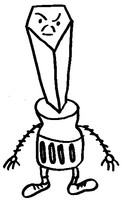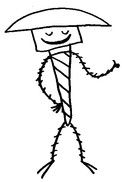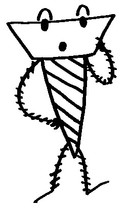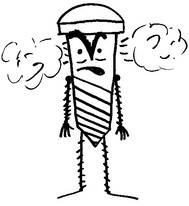
Have you ever had a team that just didn’t gel? That spent more time fighting and finger pointing than getting the job done? That showed confusion as to who was doing what? If so, you’re not alone. Many managers spend precious time refereeing team members when they should be focusing on more productive and profitable endeavors.
Why do some teams simply not get along? One reason could be that managers are seeking a certain “type” of team member, or team members just like themselves, when they should be aiming for a mix of types. For example, a toolbox with only one size or type of screwdriver would be of limited use around the house. Rather, you’d need different types of screwdrivers to tackle the various tasks. The same concept applies to the workplace. Rather than comprise your team of similar people types, you need a mix to get all the jobs done.

D. R. Iver
The first team member is D. R. Iver. You’ve probably seen this person try to take control of a meeting or project team. Some of this person’s characteristics include the ability to focus on the mission, to drive work to completion, and to hold team members accountable for deliverables. D. R. Iver is great in situations where the mission is clear and the work is well defined, when the team is in “delivery mode,” or where delivery is dependent on multiple team members completing individual tasks. On the other hand, D. R. Iver can hurt in situations where the team needs time to gel or to brainstorm ideas, or where team members are still going through learning curve. Use D. R. Iver when:

Gloom N. Doom
Gloom N. Doom is the person who always sees the glass as half-empty. These people tend to focus on why something won’t work, which can lead to them spending time worrying versus doing. Gloom N. Doom is great at providing reality checks when analyzing a solution to a problem, at testing a proposed solution prior to implementation, and when the team is unrealistic about work that can be accomplished in a given timeframe. Realize, though, that Gloom N. Doom can slow the team down when the group already has problems working together and getting motivated to perform, or when tight execution is needed without distractions. However, if you can convince Gloom N. Doom of your project’s worth, then you’re onto a winner!
Use Gloom N. Doom when:

Op T. Mystic
Op T. Mystic is Gloom N. Doom’s polar opposite, always seeing the glass as half-full and taking the viewpoint of why something can work. These people can be overly optimistic in estimating task durations, which can lead to schedule slips, but Op T. Mystic is good at energizing the team and the customers, and at thinking outside the box. Be careful of Op T. Mystic’s enthusiasm where accurate assessments of risks and issues are needed or where work scope needs to be tightly managed. Use Op T. Mystic when:

Sir Prised
Charging in on his trusty steed comes Sir Prised, with his battle cry of “Was I supposed to do that today?” Sir Prised can be very creative, excelling in unstructured environments where “out of the box” thinking is required. However Sir Prised is likely to fall down when structure in execution is necessary or when the work scope needs to be tightly managed. Use Sir Prised when:

N. Gree
Like Gloom N. Doom, N. Gree takes the viewpoint of why something can’t possibly work, but does so in an aggressively negative manner. Teamwork and civil communication are not this person’s forte, which may be why N. Gree is great at getting management’s attention. After all, most managers take notice of aggressive behavior. While this may seem like a person you would want to avoid having on your team, even N Gree can perform a valuable function when the team needs a kick-in-the-rear to get going or when the team is being unrealistic about work that can be accomplished in a given timeframe. Use N. Gree when:
Filling Your Toolbox
So, does this mean that for a team to be well balanced, it needs to contain at least one of each Toolbox Tribe member? Of course not! The skills that each member brings to the team are more important than their personality type. Remember, you couldn’t build a rocket ship if you had one of each character on the project team, but none of them was a rocket scientist! If possible, though, you should at least seek out one each of the first three types: D. R. Iver, Gloom N. Doom, and Op T. Mystic. However, if your team consists of all D. R. Ivers or all Op T. Mystics, that character’s negative qualities can end up dragging the whole team down. The same can happen if one person manages to dominate the team, even if it is well balanced. In these cases, the best tactic is for the team leader to take that person to one side and ask him or her to back down.
Lonnie Pacelli
Keynote Speaker | Board Director | Autism Advocate | Author | Project Management Expert | Microsoft/Accenture Veteran See his books on Amazon.
Fixing It All Together
In a well-structured team, each member knows what he or she needs to contribute, when each person has to perform, what the other team members are doing, and what it takes to be successful. Just as important, each team member helps the others to ensure the team’s overall success. After all, a team that works well together is more likely to pull together during the rough patches. In addition, having your team members in appropriate positions makes it easier for them to shift roles where needed and work outside their comfort zones. Whatever your team’s aims are, success comes more easily with a well-stocked toolkit.
0 Comments
Leave a Reply. |
Topics
All
Reprints
Contact Lonnie about article reprints. Please specify article you wish to reprint. Backlist
See Lonnie's Amazon Author Page Archives
July 2024
|
Lonnie Pacelli - Building Thriving Leaders™
Insightful | Creative | Direct Advice to Help Leaders Help Themselves
Keynote Speaker | Board Director | Autism Advocate | Author | Project Management Expert | Microsoft/Accenture Veteran
See his books on Amazon
Insightful | Creative | Direct Advice to Help Leaders Help Themselves
Keynote Speaker | Board Director | Autism Advocate | Author | Project Management Expert | Microsoft/Accenture Veteran
See his books on Amazon
Services |
About
|
© COPYRIGHT 2019. ALL RIGHTS RESERVED.
We are a participant in the Amazon Services LLC Associates Program, an affiliate advertising program designed to provide a means for us to earn fees by linking to Amazon.com and affiliated sites.
|

 RSS Feed
RSS Feed